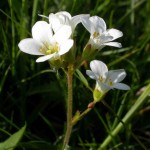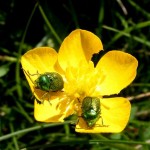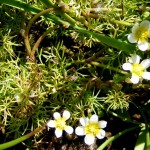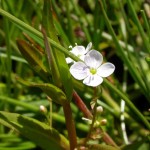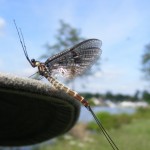Renée Grayer led a walk at Cookham on Saturday 1st June, starting from a rather full National Trust car park. A number of different species of damselfly were seen by the stream next to the path, including Blue-tailed and Large Red Damselflies and Beautiful Demoiselle. The footpath passed under a railway bridge, where ferns growing on the brickwork included Wall Rue and Hart’s-tongue. Beyond the railway, the route led into Cock Marsh. Growing in the clear water of the ditch to the right of the path were Water-violet and the leaves of Fringed Water-lily. Next came a steep scramble up through a row of Hornbeams to a higher trackway. On the steep chalk bank to the left of the path were many flowering clumps of Meadow Saxifrage. Other flowers in the chalk grassland included Salad Burnet, Horseshoe Vetch, Common Rockrose, Fairy Flax and Clustered Bellflower. Two metallic green beetles were feeding on a buttercup flower.
There are a series of ponds in the marsh at the foot of the chalk bank, each with a slightly different selection of plants. In the first pond, Water-violet, Thread-leaved Water-Crowfoot, Water Forget-me-not, Marsh Speedwell and Brooklime were noted. Another pond had sheets of Water-violet, partly in the shade of the willows, partly out in the sunshine. Another had the tall leaves of Water Dock. The furthest pond had leaves of what were thought to be Tubular Water-dropwort and Fine-leaved Water-dropwort. The walk then continued across a field with singing Skylarks to the Thames Path. The Mayflies had just hatched and a big flock of Swifts was swooping over the river and adjacent fields to feed on them. They were joined by a single House Martin. A Common Tern was feeding over the river. A few butterflies were seen during the walk, including several Brimstones and Orange-tips and two Small Coppers. The only moth of the afternoon was a Small China-mark.
Pictures by Rob Stallard and Jan Haseler


